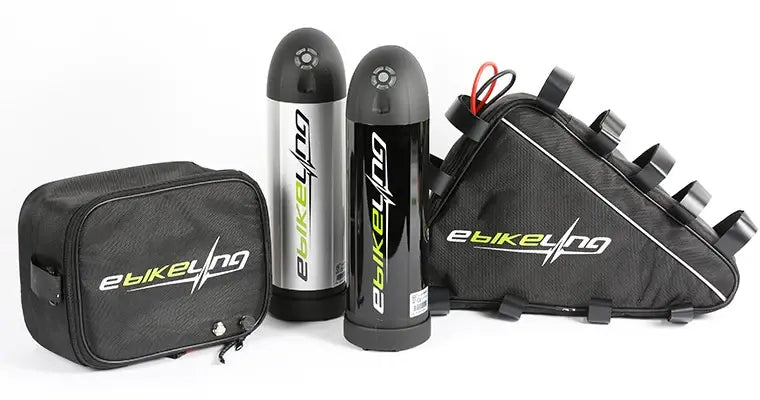In the ever-evolving world of electric bikes, the debate between 52V and 48V batteries is a big deal. Both battery types have their unique advantages, and understanding their benefits can significantly influence your electric bike experience. Whether you're looking to buy an e-bike battery or are simply curious about the topic, this guide sheds light on their differences, advantages, and other factors of note.
52V VS. 48V Batteries: The Key Differences
E-bike batteries have undergone substantial changes, with newer versions offering better performance and longer range. Let's delve deeper into the primary differences between 52V and 48V batteries:
- Speed and Power: 52V batteries, due to their increased voltage, enable your motor to spin faster. This not only provides a speed boost but also results in augmented power. Hence, whether you're navigating through challenging terrains, climbing hills, or needing that extra power thrust against strong winds, 52V batteries are a game-changer.
- Extended Range: While both batteries can offer long rides, 52V variants have a slight edge. For instance, while the A8 Pro 48V 60Ah battery offers a range between 100-130 miles, its 52V counterpart ensures a span of 110-140 miles.
- Comparable Size and Weight: Many assume 52V batteries are significantly heavier. However, the weight difference is marginal, making it almost inconsequential for riders. Plus, their sizes remain largely unchanged, ensuring a smooth fit for most e-bike setups.
- Battery Life: Since "V" signifies the battery voltage, the 52V battery naturally offers an extended battery life.
However, 48V batteries shouldn't be dismissed:
- Weight: While the difference is minimal, a 48V e-bike battery is slightly lighter than its 52V counterpart.
- Price: Cost plays a pivotal role. For example, the Aniioki A8 Pro 48V is notably $300 cheaper than the Aniioki A8 Pro 52V.
- Overall Takeaway: While a 48V battery can fulfill most riders' requirements, 52V batteries stand out in power and range. They promise enhanced hill-climbing capabilities, swifter acceleration, and a greater range.
Upgrading to a Higher Voltage Battery: Factors to Consider

Before you leap from a 48V to a 52V battery, it's essential to weigh several critical factors. While the potential for added power and speed is attractive, other considerations could influence your decision. Let's take a closer look at what you need to factor in before making the switch.
#1. Price
Upgrading to a 52V battery often comes with a higher price tag than sticking with the 48V. While the initial investment might seem steep, consider the long-term benefits of added speed, power, and range. Will these advantages translate into value for you over time? Does your e-biking frequency justify this additional cost? It's crucial to weigh the immediate financial implications against the potential benefits to determine if the upgrade is worth it.
#2. Charger
When transitioning to a higher voltage battery, there's a likelihood that your existing charger might not be compatible. This means additional investment in a new charger tailored for the 52V battery. Research the types of chargers available, their costs, and reviews. A reliable charger is essential, not just for ensuring your e-bike's performance but also for the longevity of the battery. All of eBikeling batteries are bundled & shipped with a compatible charger for each specific e-bike battery.
#3. Maintenance Costs
High voltage batteries, while delivering on performance, might have specific upkeep needs. These could range from specialized cleaning agents to particular storage requirements. It's worth knowing what these are and how they might impact your ongoing maintenance costs. Additionally, determine if there are any special procedures or precautions to be followed to ensure the battery's optimal performance.
#4. Battery Life Expectancy
One of the selling points of the 52V battery is its extended life. But it's not just the voltage that determines a battery's longevity. Factors such as build quality, usage patterns, and charging habits play a role. Investigate the expected life expectancy of the 52V battery you're considering. Compare it with the lifespan of your current 48V to see if the upgrade makes sense in the long run.
#5. Your Demands

Understanding your riding habits and requirements is paramount. Are you an avid e-biker who craves more power and longer rides? Or do you use your e-bike occasionally for short trips? If you're content with your e-bike's current performance, upgrading might not be necessary. However, if you're looking for that extra oomph in power, speed, or range, the 52V battery could be precisely what you need. Evaluate your demands and see where they align.
Conclusion
Both 52V and 48V batteries for electric bikes have their set of pros and cons. While the former promises enhanced performance and range, as well as the same or better power output per watt, the latter is a cost-effective solution that caters to most riders' needs. Your decision should align with your e-bike usage pattern, budget, and long-term goals. If you're considering an upgrade or need guidance on making the right choice, visit the eBikeling e-bike batteries online store. Our experts are always ready to guide you through the process and ensure you make an informed decision.









